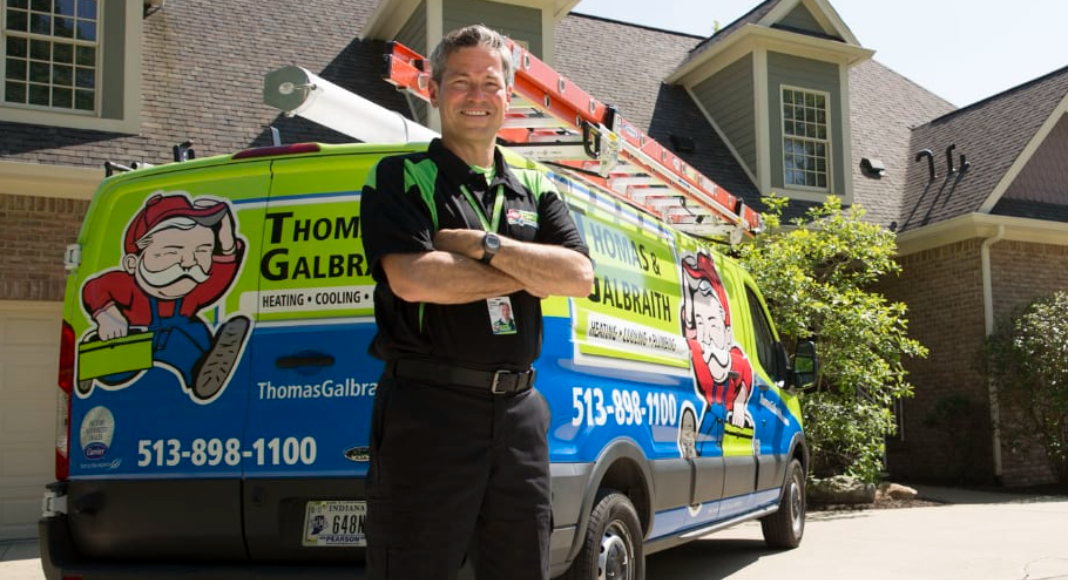
It’s official – the cooler temperatures of fall are soon to arrive in Dayton. Imagine, a week of brisk evenings, sweater weather, and firepit chats. One night, just before you tuck your kiddos into bed, you decide it’s time to flip the switch to heat…
But nothing happens.
Thomas & Galbraith Heating, Cooling & Plumbing have Dayton’s families in mind this fall! They want to ensure your HVAC system is ready to heat your home with maximum efficiency once the weather turns.
So the only thing you need to worry about is how to make it through reading “Good Night, Moon” for the zillionth time.
Dayton’s moms trust the maintenance advice from Thomas & Galbraith’s licensed HVAC professionals. The friendly team at Thomas & Galbraith has provided us with tips to prep your furnace, heat pump, or boiler for the cooler months ahead, including:
- Scheduling professional fall HVAC maintenance tune up service
- Evaluating summer setpoints and adjusting temperature settings for fall
- Cleaning the heating and cooling system outdoor unit
- Replacing air filters
- Maintaining proper airflow by keeping vents open
- Providing maintenance tips for safety when using a natural gas, propane, or oil heating unit
With a little know-how, you can care for your heating and air conditioning unit, even with the heavy use of winter. This preventative maintenance advice helps your system consume less energy, your energy costs stay affordable, and your family keeps comfortable, no matter what!
Book a Preventative Maintenance Services Now
If you’ve read any blogs about fall HVAC system maintenance care, you know a yearly professional servicing is the best thing you can do for your furnace, heat pump, or boiler… which is why you see this advice repeated about as much as “are we there yet” on a car trip!
Yet… we are moms. We have kids with lots of needs, sports costs, ballet shoes, class trips, and orthodontist bills! There is only so much left over.
Lucky for us, Thomas & Galbraith understood that and said if you can only able to do one of their maintenance tips, they’d recommend scheduling preventative maintenance for your HVAC system!
Heating equipment needs one HVAC maintenance tune up each year, as does the home’s air conditioning system. If you use a heat pump, that system needs both tune ups in a year’s time as it runs as a heater and an air conditioner.
How Does HVAC Maintenance Benefit a Heater?
- During a preventative maintenance service, an HVAC professional inspects the condition of your heater to verify all system components are in good shape and working correctly.
- If they’re not, a skilled tradesperson will examine every inch of your unit to identify performance flaws in need of repair. Any repairs can then be made at the time of service… so no need to try to schedule another appointment!
- You won’t be stuck waiting with cold, shivering, and crying kiddos when the heater fails to turn on during the first day of cold weather, nor be forced to call for emergency repairs that cost a lot more money.
- Tune ups deliver the TLC an HVAC system needs to operate at peak energy efficiency through the cold months, which means your energy bills will be lower and you’ll save money not only on electricity or gas, but with fewer repair bills to pay! Hello, Starbucks!
- Your heating system will last longer without wear and tear damage adding up each year, so you have more time between new system replacements for your home.
What Happens During Professional Fall HVAC Maintenance Service?
When you schedule an appointment for Dayton heating service with Thomas & Galbraith, the actual steps involved depend on the type of HVAC equipment in use. The service usually takes about an hour to complete and can involve tasks such as:
- Oiling the bearings inside the blower motor
- Cleaning coils in the outdoor condenser
- Tightening all electrical connections
- Checking for cracks in the heat exchanger
- Measuring temperature drop and air flow rates
- And other care your system needs to function at its best
HVAC Maintenance Tips for DIYers
While professional maintenance is second to none in terms of caring for your heating system, there are additional tasks we should perform outside of these annual appointments.
I know we are all busy and adding another thing to our to-do list seems overwhelming, but without these routine maintenance tasks, the efficiency and performance of your heating system or air conditioner could be greatly compromised.
A good rule of thumb is to perform these steps in the fall, but it’s helpful to repeat them through summer, spring, and winter, too!
Air Filter Maintenance
Your HVAC system is supplied with proper airflow when you replace air filters on a regular basis.
To do this, pull out the current air filter and examine the media. If it looks thoroughly caked with dust, dirt, and debris, toss it and replace it with a new air filter. If it’s hard to tell, shine a light through the air filter – if the light can be seen through the filter, it will last a little longer if needed.
Check the system’s air filter each month to decide if the air filter should be replaced. Clean air filters help the HVAC system, air conditioner or heater, maintain air flow so it doesn’t overheat or use more energy than needed.
Outdoor Unit Maintenance
Remove debris stuck to the AC and heat pump’s exterior. Vegetation growing up against it, limbs encroaching on the outdoor condenser, and outdoor items stored up against the equipment prevent adequate air movement to exchange heat energy.
If your home is heated by a heat pump, you need to keep this up throughout the year as this system produces warm air for the home using the outdoor components. During air conditioning season, keep the outside air conditioner unit clean and clear of debris.
Keep Vents Open or Closed?
Have you ever heard someone say to close vents in parts of your house that you don’t regularly use to save energy and money? Thomas & Galbraith told us it is actually bad information and can be quite harmful.
With all vents open, your HVAC system will function as it’s designed to, keeping enough air moving through the home and unit to avoid overheating and excess pressure in the duct system – both of which can cause damage and energy loss.
Go through each room of the house and check the vents. If you have louvered register covers, make sure the louvers are set to the open position and are not jammed due to dust and debris buildup.
Don’t forget to remove heavy furniture, carpeting, and other belongings sitting on top of or otherwise blocking registers to supply or return ducts.
Discover Drafts and End Them
Drafty windows, doors, and more cause a home to waste heated air. The air and the energy used to warm it escape into the outdoors.
Find and seal drafts this fall so your house keeps in more of the warm air your furnace or heater creates during the cold months.
Common drafty areas are frames around windows and doors, pipe or wire penetrations running between the interior and exterior of the house, attic hatches, chimneys, and more.
Check Thermostat Settings and Adjust the Temperature for the Cooler Months
When you shut off the air conditioning for the year, it’s time to reevaluate thermostat settings and make adjustments for the fall and winter!
- If your goal is to maximize energy efficiency while staying comfortable and warm, program the thermostat temperature to 68 degrees for times when people are indoors and active in the home.
- To increase your savings, lower temperatures by 7 to 10 degrees over a span of eight or more hours a day. Doing this can reduce HVAC energy use up to 10 percent, and you won’t notice a difference when you’re at work all day or asleep overnight.
- Make sure thermostats are able to accurately communicate with the home’s HVAC equipment at all times or else temperatures may be off indoors. Replace batteries every six months, even if the current batteries are not dead. Even hardwired thermostats should have batteries installed as a backup source of power in the event of a tripped breaker or other electrical issue.
Fall HVAC Safety Tips
While comfort is a homeowner’s primary cool weather HVAC concern, safety is important, too. If you have a heater that uses natural gas, liquid propane, or heating oil, Thomas & Galbraith’s tips will help you keep your family safe and warm.
- Keep combustible products and flammable materials away from the unit. Don’t store or use them nearby. Leave a minimum of 30 inches clear on all sides of your heater.
- Test all carbon monoxide detectors and smoke alarms monthly. Replace them if the alarm doesn’t play, isn’t loud, or the unit has reached its expiration date (carbon monoxide detectors should be replaced every five to seven years, smoke detectors every 10 years).
- Change batteries in all carbon monoxide and smoke detectors every six months, even if they aren’t dead yet.
- Beware that you may experience a burning odor when you first run the furnace or heater after several months off. Dust, dirt, and debris collect as the system sits dormant and they burn off when the unit starts up again. If the smell bothers you, run the blower motor fan or bathroom exhaust fans, or crack windows to clear it out faster. If the odor lasts more than an hour or smells more like an electrical fire or metallic burning smell, turn off the HVAC system and contact your heating company for repairs before you continue to use the system.
- A rotten egg smell is a sign of a gas leak, which could come from your furnace, boiler, gas water heater, oven, or even a damaged gas utility line. If you detect this smell, get everyone out of the house fast and don’t do anything that could cause sparks that could ignite the gas. Call 911 and don’t go back inside until an official tells you it is safe. Depending on the source of the leak, you may need to call your HVAC or plumbing company to make repairs before using the faulty gas appliance again.
Cross Fall HVAC Maintenance Off Your List!
With Thomas & Galbraith’s furnace maintenance tips, you can rest assured your heating systems will be in good shape and running as efficiently as possible this year.
To see why so many Dayton mom’s trust Thomas & Galbraith, contact their team to schedule your heating tune-up service.
“We recently dealt with some sewage backups this Summer, and Thomas & Galbraith were our first choice of whom to call. They got out to us quickly, we got a pretty thorough education on what all could be going on, what our options would be, etc. I even had a call from the regional district supervisor to let me know that they are all about educating homeowners and then letting us make the choice we feel is best. I love that they aren’t pushy sales people; they are truly there to educate and then provide services as requested. Last time they came out, I asked the guys to schedule our HVAC tune up as well as these temperatures started to fall! I love their straightforward pricing and their customer service. I definitely recommend Thomas & Galbraith for all your HVAC and plumbing needs.”
– Courtney Snow, Cincinnati/Dayton Mom Collective Owner














